- Home
- international
- news
- Photos show the USS Eisenhower carrier strike group's 9-month deployment leading the ferocious Houthi fight
Photos show the USS Eisenhower carrier strike group's 9-month deployment leading the ferocious Houthi fight
Lauren Frias

- Carrier USS Dwight D. Eisenhower recently returned home after a deployment for the history books.
- The aircraft carrier sailed on the front lines of the Red Sea fight against Houthi attacks.
A US Navy carrier and its strike group returned home earlier this month after a grueling nine months fighting Houthi rebels in the Red Sea.
During the USS Dwight D. Eisenhower's twice-extended deployment, the carrier bore the brunt of the fight in the Red Sea as its air wing and destroyer squadron fended off relentless Houthi attacks and struck inside Yemen, in the process notching some firsts in warfare.
The USS Dwight D. Eisenhower, a nuclear-powered aircraft carrier, left the Middle East on June 22 and returned to its homeport at Naval Station Norfolk on July 14. The Red Sea fight has attested to the combat power of carrier strike groups while still increasing strain on a fleet that can't fight this way forever.
USS Theodore Roosevelt, also a Nimitz-class carrier, is en route to replace the Ike Carrier Strike Group in the fight against the Houthis.
Photos captured operations on and off the storied aircraft carrier during its historic nine months at sea.
Virginia, USA
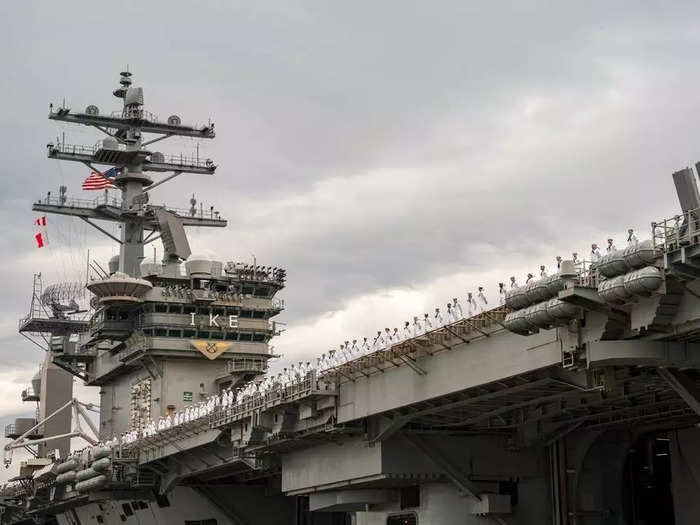
A week after Hamas militants attacked southern Israel on October 7, 2023, the Pentagon deployed the Ike and its strike group as a show of power and support for Israel.
Alongside the Gerald R. Ford Carrier Strike Group, the Ike Carrier Strike Group was the second one sent to the Eastern Mediterranean Sea to deter escalation in the Israel-Hamas war.
The crew aboard the Ike manned the rails as it departed its homeport of Naval Station Norfolk in Virginia on October 13, 2023.
Mediterranean Sea
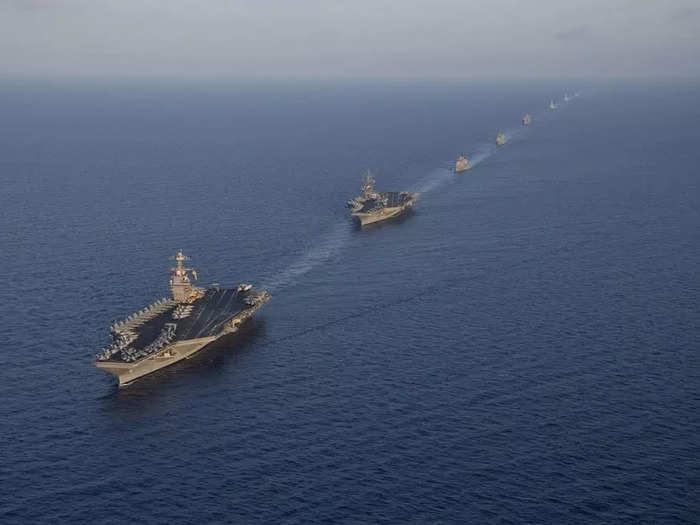
While transiting the Mediterranean in early November, the Ike participated in a photo flyby with the Ford and other warships, including Italian frigates, operating in the region in a "show of force" in the eastern Mediterranean.
Gulf of Aden
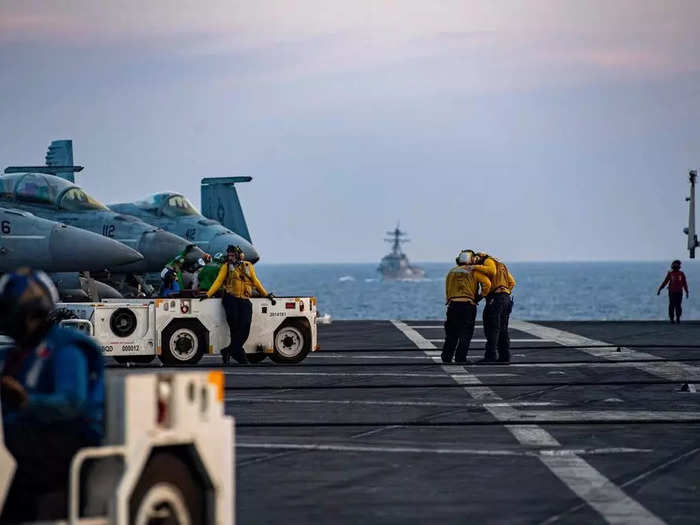
While the Ike was initially deployed to the eastern Mediterranean as a show of force against Hamas, the Pentagon later shifted the carrier's focus to defending key shipping lanes and international vessels from Iranian-backed Houthi rebels off the coast of Yemen.
Gulf of Oman
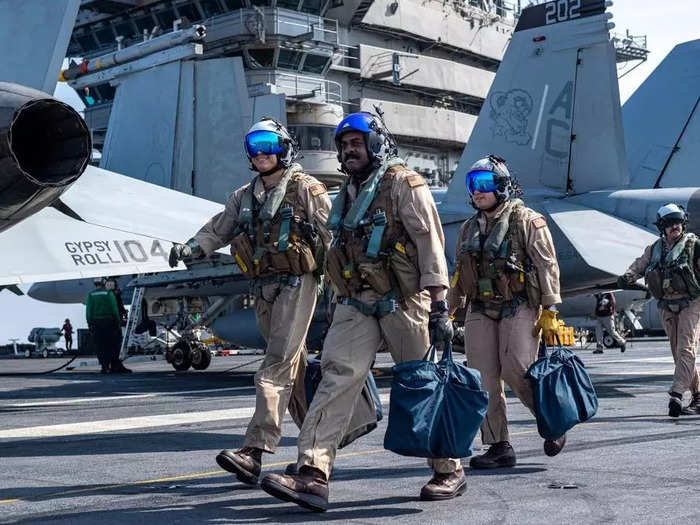
In November, the Ike briefly moored in the Port of Duqm, Oman, for a three-day visit — one of the few port calls the carrier made throughout its monthslong deployment.
Thanks to supporting vessels in its strike group, including the replenishment oiler USNS Kanawha, the dry cargo ship USNS Alan Shepard, and the fast combat ship USNS Supply, the Ike was able to sustain itself for long stretches of time with minimal port calls.
Persian Gulf
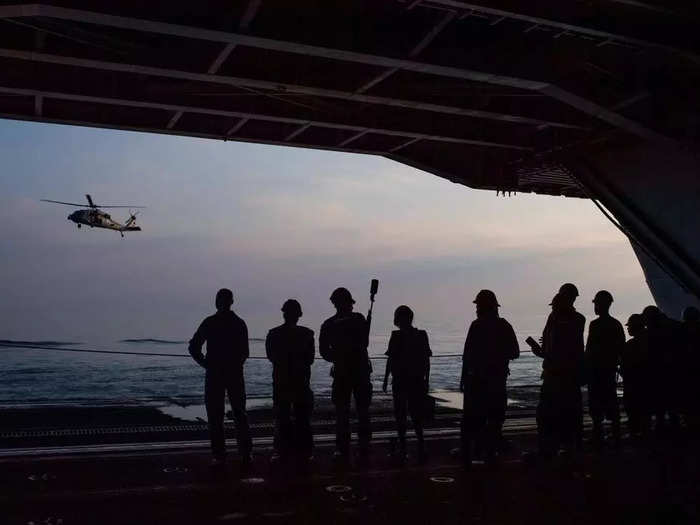
In late November, the Eisenhower and its escorts entered the Persian Gulf via the Strait of Hormuz, marking the first time a Navy carrier had been present in the maritime flash point since carrier USS Nimitz in 2021.
While it was "conducting routine flight operations" in the Persian Gulf, Vice Adm. Brad Cooper, then-commander of US Naval Forces Central Command, said an enemy drone flew dangerously close to the carrier.
No injuries or damages were reported in the November 2023 incident.
Cooper said the unmanned aerial vehicle, which was "visually identified as Iranian," came as close as 1,500 yards to the Ike, violating safety precautions directing drones to stay at least 10 nautical miles away from the vessel.
"This unsafe, unprofessional, and irresponsible behavior by Iran risks US and partner nation lives and needs to cease immediately," NAVCENT said in a statement at the time.
Southern Red Sea
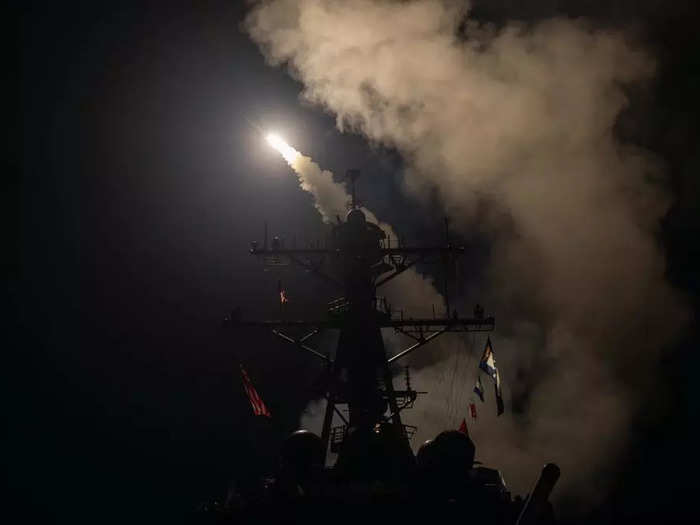
But the near-brush with the Iranian UAV was the first of many encounters the Ike and its fellow warships would have with Houthi drones and missiles as 2023 came to a close.
The destroyers USS Laboon, Mason, and Gravely, all of which deployed with the Ike, defended and assisted several commercial ships targeted by the Houthis.
The Navy destroyers collectively took out dozens of drones, as well as multiple land attack and anti-ship ballistic missiles, launched by the Houthis.
During the last weekend of December, the Ike and destroyers Laboon and Gravely responded to a distress call from MV Maersk Hangzhou, a Singapore-registered, Danish-owned cargo ship that came under fire from Houthi rebels in the southern Red Sea.
USS Gravely shot down two anti-ship ballistic missiles, while Navy helicopters embarked on the Eisenhower "returned fire in self-defense" as Houthi militants attempted to board and seize the commercial vessel, CENTCOM said in a statement at the time.
The Gravely and helicopter squadron sunk three Houthi small boats and killed 10 crewmembers — the first time the US Navy killed Houthi fighters since the Red Sea conflict began.
Red Sea
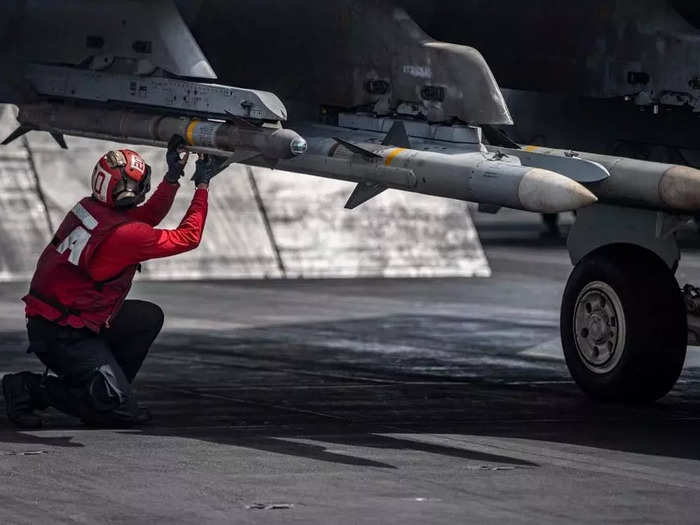
As the conflict in the Red Sea continued to escalate into the new year, F/A-18 fighter jets aboard the Ike supported the Navy destroyer squadron and the British warship HMS Diamond after Houthi rebels launched "complex" airstrikes on ships in the Red Sea.
Two cruise missiles, one ballistic missile, and 18 Iranian drones were shot down in the combined effort that took place in early January, which was seen as a final warning to the Houthis to stop threatening international shipping vessels.
Cmdr. Benjamin Orloff, commanding officer of the Rampagers, an F/A-18E Super Hornet fighter squadron attached to the Ike, said the operations in the Red Sea required an "incredible amount" of collaboration, innovation, and ingenuity to "come up with new tactics, to tweak systems that we already have, in order to optimize our employments."
"We developed an awful lot from this fight that I think has an incredible amount of applicability to current and future conflicts around the globe," Orloff told USNI News.
Strikes inside Yemen
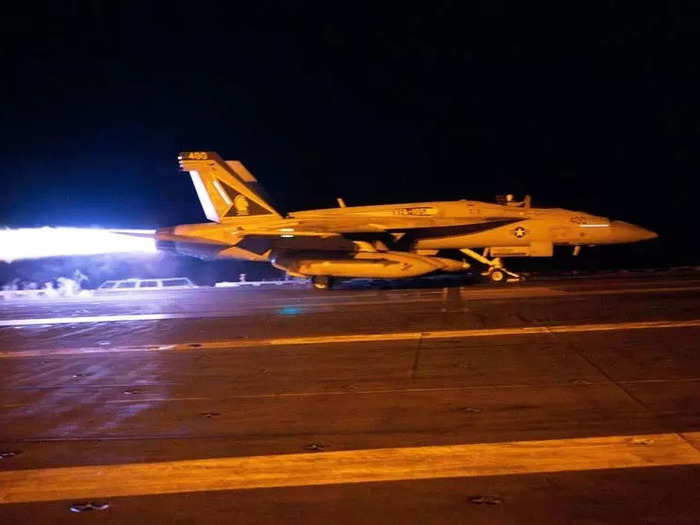
The US and UK launched a series of retaliatory airstrikes against the Houthi militants in mid-January.
Armed forces led by the US and UK, with support from Australia, Bahrain, Canada, and the Netherlands, used more than 100 precision-guided munitions on more than 60 Houthi targets in Yemen.
A little over a week following the intense multinational strikes, the US continued to pummel Houthi targets, including an underground storage site and key missile and air surveillance locations.
Capt. Marvin Scott, commander of Ike's Carrier Air Wing 3, acknowledged the unprecedented nature of the Ike operating at the front lines in the Red Sea.
"It was something we really haven't seen — for a carrier strike group to be close to that kind of fight — really since World War II," Scott said earlier this month, referring to the high-tempo combat environment that took place in the Pacific theater.
"We responded precisely, violently to degrade their capability, destroying their methods to wage war — essentially, their one-way attack UAVs, their anti-ship ballistic missiles, their anti-ship cruise missiles," he added. "That's what we've been targeting to get them to stop targeting merchant vessels and the Red Sea."
Souda Bay, Greece
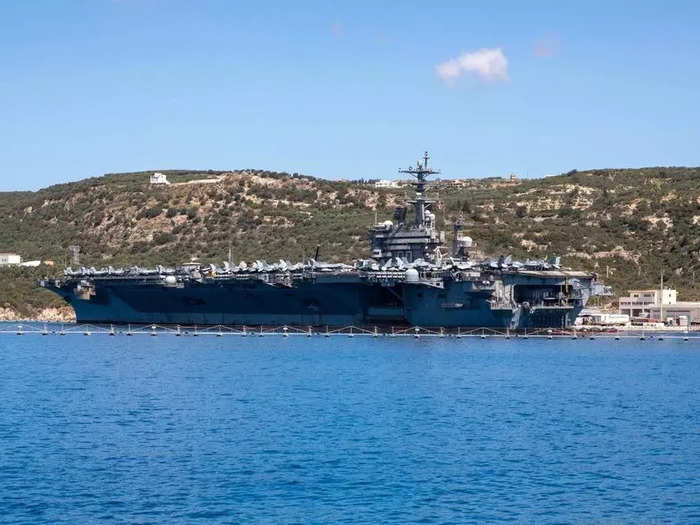
In late April, the Eisenhower traveled back to the eastern Mediterranean and moored at US Naval Support Activity Souda Bay in Greece for four days to refuel, resupply, and rearm after more than 150 consecutive days at sea.
Rear Adm. Marc Miguez, commander of Carrier Strike Group 2, said the long-awaited port visit was "well-deserved."
"The sailors of Carrier Strike Group 2 have worked tirelessly for six months straight to keep us operating on station in the most challenging, dynamic combat environment the Navy has seen in decades," Miguez said in a statement.
Though the carrier strike group was nearing the end of its scheduled seven-month deployment — the standard duration for US carriers — Defense Secretary Lloyd Austin extended their operations in the Red Sea as the conflict showed little signs of slowing down.
Northern Red Sea
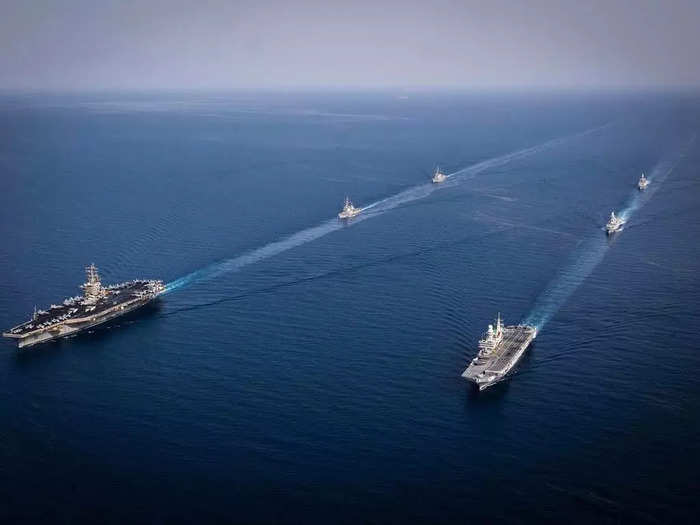
The Ike and its accompanying destroyers continued to operate in the northern Red Sea off the coast of Saudi Arabia. The group participated in a photo exercise with Italian navy vessels, including aircraft carrier Cavour and guided missile frigate ITS Alpino, as well as French anti-air frigate Forbin.
En route to the Mediterranean
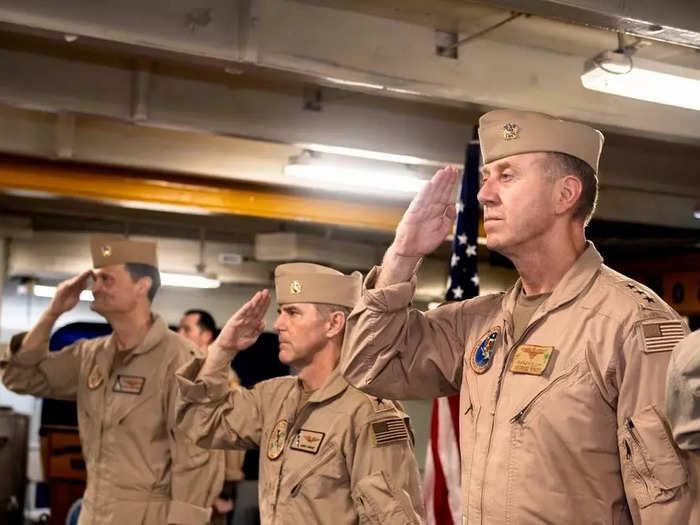
In mid-June, the Ike also hosted a change-of-command ceremony.
Rear Adm. Kavon Hakimzadeh, who previously commanded the aircraft carrier USS Harry S. Truman, relieved Rear Adm. Miguez as commander of CSG-2.
"Words cannot express how honored I am to have served among these battle force warriors," Miguez said during the ceremony, adding that the Ike strike group delivered "decisive combat power to preserve freedom of the seas."
The battle's tally
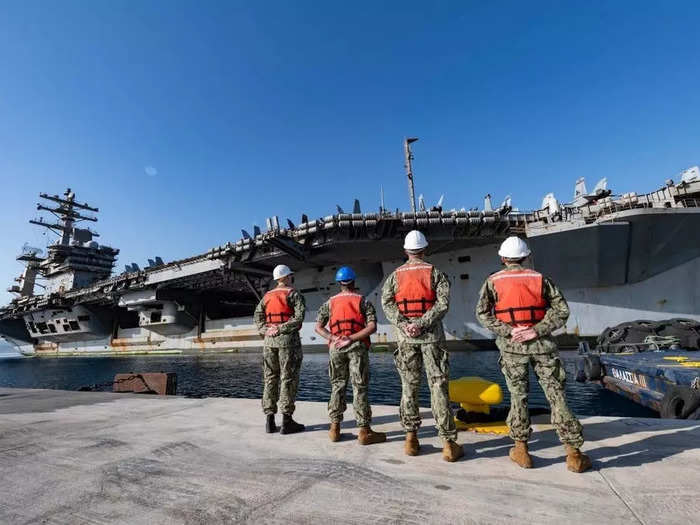
Austin announced that the Ike strike group would stay in the Red Sea for a little while longer after extending their deployment for a second time in June, underscoring their critical role in deterrence efforts.
After nearly nine months of battling the Houthis in the Middle East, a Navy tally released in mid-July reported that the Eisenhower and its attached warships and aircraft fired nearly 800 munitions, including Standard Missile interceptors, Tomahawk strike missiles, air-to-air missiles, and air-to-surface weapons.
The Ike CSG's aircraft logged more than 27,000 flight hours over 12,000 sorties, according to Lt. Cmdr. Lauren Chatmas, a Navy public affairs officer.
A few weeks after the deployment extension, the Pentagon deployed the USS Theodore Roosevelt Carrier Strike Group to the Middle East.
The carrier and its cruiser returned to Souda Bay for another brief port visit in preparation for the long journey home. The destroyers in the strike group were initially set to remain in the US 5th Fleet, USNI News reported, but have since returned to their respective homeports at Naval Station Norfolk and Mayport.
Ionian Sea
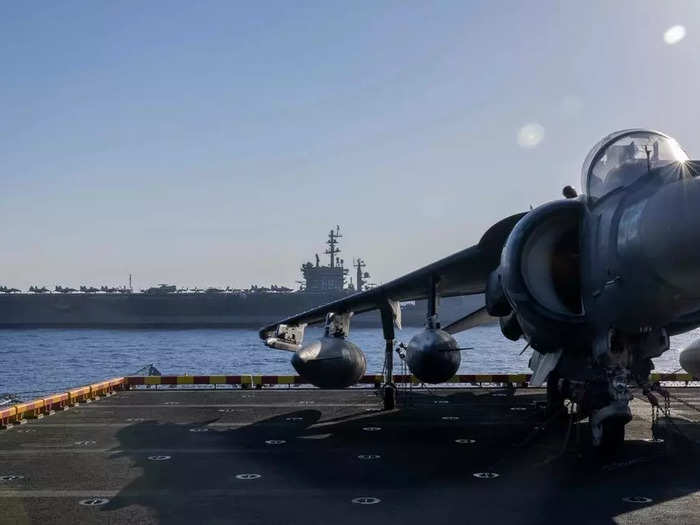
In late June, the Eisenhower briefly operated in the the US European Command area of responsibility, where the carrier participated in the final photo flyby of its deployment.
Virginia, USA

After 275 days at sea, USS Eisenhower returned to its homeport following its historic, twice-extended deployment.
Sailors and crew aboard the Ike came back to a tearful homecoming, reuniting with their loved ones after enduring nine months of intense combat.
President Joe Biden addressed sailors over the intercom, commending the ship's crew for their service.
"You're part of the greatest navy — this is not hyperbole — the greatest navy any nation has ever, ever put to sea," Biden said. "That's a fact."
Popular Right Now
Popular Keywords
Advertisement